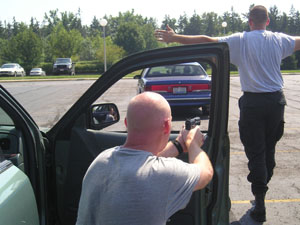By Janie Southard
jsouthard@dailystandard.com LIMA -- It seems like a routine traffic stop. But this time the people in the car are high on dope and armed to the teeth. Stop signs and speed limits mean nothing, except to the cop who pulls this car over.
 dailystandard.com"> dailystandard.com">
Herein lies one of the first rules for men and women enrolled at the Basic Police Academy at James A. Rhodes State College criminal justice department.
"There are no routine stops, period. You can't imagine how wrong things can go and how fast," said William W. Applegate, BPA instructor and retired St. Marys chief of police at his Rhodes College office last week.
The BPA cadets, 93 from Auglaize and Mercer counties since 2001, have gone through rigorous training to learn to automatically react to the unexpected.
Last Wednesday the training focused on stops and approaches. A dozen cadets took turns driving the violator cars or the police vehicles in a series of staged scenarios on a few acres of parking lots at the college. One scenario called for a traffic stop of a vehicle containing five people with drugs and guns. However, those in the police cars had no idea what the situation would be. The training is how to approach the vehicle and to get the people out of a two-door car. The guns and drugs are an added dimension calling for the ability to react effectively.
The 600-hour course is operated at Rhodes in conjunction with the Allen County Sheriff's Office and the Lima Police Department and it's not for couch potatoes.
"Applicants should be prepared to participate in rigorous physical activities" states the orientation booklet.
"You have to pass a physical before you can begin the course. And you have to pass a physical to graduate. And, then you have to pass a physical as part of the state test," said Applegate. Being prepared to take the state test is the goal of the academy. As well, the academy course can amount to 33 credit hours toward a degree in any one of several study programs at the college.
The requirements for one minute of sit ups, push ups and the 1.5 mile run are age- and gender-specific. For example, women under 29 years old need to do 35 sit ups compared to like-aged men doing 40, and the same continues up the age scale.
The physical requirements are strictly enforced and cadets devote a lot of time to getting themselves in shape. "I've seen them fail because they missed the run time by one-tenth of a second. It's a tough break, but that's the way it is.
"This is not an easy course. People may think you come here to shoot at targets and that's the end of it, but it just ain't so," he said.
In addition to the physical aspects, the cadets must memorize hundreds of Student Performance Objectives (SPOs). These are standards, many from the Ohio Revised Code, on which the state test is based, including ethics, proper arrest, search and seizure, crisis intervention, community policing, etc.
The long room where classes are held resembles a busy office workroom: messy with books and manuals, various law enforcement equipment stacked here and there, a shirt or two hanging off the back of a chair, a couple pairs of heavy black boots. The only non-essentials in this serious setting are a coffeepot and a popcorn machine.
A whole host of professional law enforcement officers serve as instructors including Officer Mark Ernst of the St. Marys Police Department. Ernst also does undercover work in counties other than Auglaize and has served eight years on the local Drug Task Force.
"It's not unusual to run into some guy who's a whole lot bigger than you, someone you know is capable of getting the best of you in a physical encounter. So, in that instance, and actually in almost every instance, it's interpersonal skills that save you," Ernst said relating the same insight he provides the cadets.
Applegate injected an axiom he's developed over his 30-some years of police work: "If the guy's got more tattoos than teeth, you can't hurt him. You need that verbal judo."
Back in the parking lot, Officer Larry Curl of the Shawnee Township department and an academy instructor, is putting the cadets through their paces on stops and approaches, this time involving the armed occupants in the two-door car.
"The approach we're using is the left-side tactical. They're checking out the trunk and the back seat and keeping out of the view of the mirrors.
"We're looking to see if the trunk is ajar. What are the people in the backseat doing. Plus, is the driver nervous. Is there movement that they're hurrying to hide something," explained Curl as the cop-group with guns drawn and using car doors as shields yelled at the two-door occupants to "step out of the car, now."
The exercise went well. The five occupants were arrested and placed in three different police cars. No one was hurt -- except perhaps those cadets portraying the offenders who had to walk backwards on their knees on an August-hot blacktop parking lot. |

